中西方肢体语言的差异【英汉对照】
中美肢体语言差异英语作文

中美肢体语言差异英语作文题目:Cultural Nuances in Gestures: A Comparative Studyof Chinese and American Body LanguageIn the intricate dance of human interaction, bodylanguage plays a pivotal role, silently conveying what wordsoften leave unsaid. A fascinating exploration lies in thedisparities between Chinese and American nonverbal cues,shaped by their unique cultural milieus and historical contexts.This essay delves into these divergences, underscoring theimportance of cultural sensitivity in global communication.At its core, Chinese body language tends to be morereserved and subtle. Respect for hierarchy and collectivismdeeply influences gestures. For instance, nodding the headslightly instead of a vigorous nod signifies agreement,reflecting a preference for humility. During conversations,maintaining eye contact can be misconstrued as aggression orlack of respect, especially with elders or authority figures. Incontrast, physical contact such as backslapping or hugs,common in Western cultures, is infrequent amongacquaintances in China, preserving personal space anddecorum.On the American front, body language is characterized byopenness and expressiveness. A firm handshake accompanied by direct eye contact is the norm upon meeting, symbolizing confidence and sincerity. Americans tend to use expansive gestures and animated facial expressions to emphasize points, reflecting a culture that values assertiveness and individuality. The "thumbs up" sign, while universal for approval, might carry a more casual or even playful connotation in the U.S., differing from its more formal usage in some Asian contexts.One notable difference lies in personal space. Americans generally prefer more personal space, with an arm's length distance considered comfortable in social settings. In contrast, Chinese individuals may stand closer during conversations, reflecting a culture that values proximity and intimacy in relationships. This can lead to misunderstandings if not recognized and respected.Another intriguing contrast emerges in the interpretation of certain gestures. While smiling is a universal sign of friendliness, constant smiling in the U.S. can be seen as polite and encouraging, whereas in China, excessive smiling during serious discussions might be misinterpreted as insincerity or lack of professionalism.It is crucial to remember that within both cultures, thereexists a spectrum of individual variation. Nevertheless, awareness of these broad patterns fosters effective communication. As we navigate the globalized world, recognizing and adapting to these cultural nuances becomes imperative. Misreading body language can inadvertently cause offense or confusion; conversely, appropriate usage fosters rapport and mutual understanding.the disparities in body language between China and America underscore the richness of cultural diversity. By acknowledging these differences and striving to understand their roots, we equip ourselves with a powerful tool for bridging cultural gaps. Whether in business negotiations or casual encounters, the ability to decode and respond appropriately to nonverbal cues serves as a passport to smoother international interactions.。
中西肢体语言差异英语作文

中西肢体语言差异英语作文英文回答:Body language is a form of non-verbal communicationthat can convey a variety of messages, from emotions and intentions to cultural background. While there are some universal gestures that are understood across cultures, there are also many differences in how body language is interpreted and used around the world.One of the most striking differences between Western and Chinese body language is the use of eye contact. In Western cultures, making eye contact is generally seen as a sign of respect, confidence, and sincerity. However, in Chinese culture, making direct eye contact can be seen as challenging or disrespectful, especially when speaking to someone who is older or of a higher social status.Another difference between Western and Chinese body language is the use of gestures. In Western cultures,people often use gestures to emphasize their words or to convey emotions. However, in Chinese culture, gestures are often more subtle and reserved. For example, while Westerners might use a thumbs-up gesture to indicate approval, Chinese people might use a nod of the head or a slight smile.The use of personal space is also different between Western and Chinese cultures. In Western cultures, people tend to value personal space and may feel uncomfortable if someone stands too close. However, in Chinese culture, people are more accustomed to close physical contact and may not be offended if someone stands close to them.These are just a few of the many differences between Western and Chinese body language. By understanding these differences, we can avoid misunderstandings and communicate more effectively with people from different cultures.中文回答:肢体语言是一种非语言沟通形式,可以传递各种信息,从情感和意图到文化背景。
中西方身体语言的差异例子

中西方身体语言的差异例子中西方文化背景不同,因此在身体语言上也存在一些差异。
以下是一些例子,展示了中西方身体语言的差异。
一、面部表情1.微笑:在西方文化中,微笑通常表示友好或愉快。
而在中国文化中,微笑可能有多种含义,如礼貌、害羞或尴尬。
2.眼神接触:在西方文化中,直接的眼神接触被视为自信和尊重。
而在中国文化中,直接的眼神接触可能被视为不礼貌或傲慢。
二、姿势和动作1.握手:在西方文化中,握手是一种常见的问候方式,表示友好和尊重。
而在中国文化中,握手通常不如西方文化中普遍,而是以鞠躬为主要方式。
2.肢体接触:在西方文化中,肢体接触通常较为普遍,如拥抱、拍肩等,表示亲近和关怀。
而在中国文化中,肢体接触较为保守,通常只在亲密关系中出现。
三、姿态和姿势1.坐姿:在西方文化中,常见的坐姿是直立或稍微向后倾斜。
而在中国文化中,坐姿通常是直立或稍微向前倾斜,以示尊重。
2.手势:在西方文化中,挥手表示告别或打招呼,而在中国文化中,挥手通常表示离别或招呼。
此外,竖起大拇指在西方文化中表示赞成,而在中国文化中表示不好。
四、身体接触1.接吻:在西方文化中,接吻通常是一种亲昵的行为,如亲吻脸颊或嘴唇。
而在中国文化中,接吻通常只在亲密关系中出现,不像西方文化中那么普遍。
2.拥抱:在西方文化中,拥抱是一种常见的亲密行为,表示关怀和亲近。
而在中国文化中,拥抱通常只在亲密关系中出现,不像西方文化中那么常见。
五、手势和动作1.点头:在西方文化中,点头通常表示同意或理解。
而在中国文化中,点头可以表示同意、理解或尊重。
2.摇头:在西方文化中,摇头通常表示不同意或否定。
而在中国文化中,摇头可以表示不同意、否定或表示歉意。
六、姿势和动作1.手势:在西方文化中,举起手掌表示停止或等待。
而在中国文化中,举起手掌可能表示不理解或表示抗议。
2.手指:在西方文化中,竖起食指表示“好”或“正确”。
而在中国文化中,竖起食指可能被视为不礼貌或侮辱。
七、身体姿势和动作1.微笑:在西方文化中,微笑通常表示友好和愉快。
the english-chinese contrast of body language(肢体语言英汉对比)
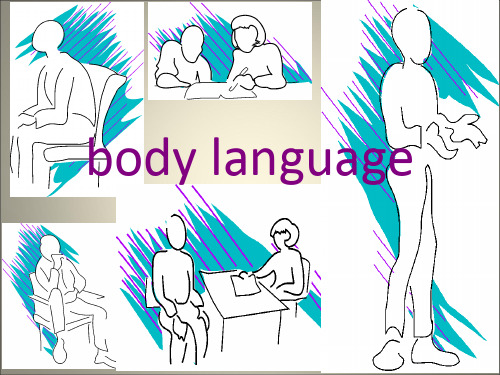
2012-10-26
(2)Eye contact
Rules about eye contact : Look or not to look When to look and how long to look Who and who not to look at ,etc
All cultures have their unique social rules governing their eye contact .
No 2 /scissors
“V “
(With the palm in)
In other European countries ,it means “going away ”, especially in Britain , it means “shameless things”
The beckoning gesture
2012-10-26
“V”(with the palm out )
Victory:
In the world war 2, created by Victor ·Della Wally .
Widely spread after British prime minister , Churchill ,used it in a parade.
Smile : welcome , friendly, joy etc Also : embarrassment /nervous/uncomfortable
Americans
• Outgoing
Open to show their happy emotion .
2012-10-26
Chinese
Handshaking has become an accepted touch between businesspeople when they first meeting
中西方肢体语言的差异的例子

中西方肢体语言的差异的例子
1. 咱就说,在西方,拥抱可是很常见的打招呼方式呢!比如朋友见面就会来个大大的拥抱,而在中国,可能更倾向于点头微笑或者握手来表示友好,你说是不是很不一样呀!
2. 哎哟喂,西方人表示赞同时会竖起大拇指,这多直接呀!可中国人有时候会用点头来表示认可,这差别可不小吧!
3. 嘿,你知道吗?在西方,耸肩摊手表示无奈的情况好多呀!但中国人可能就会叹口气或者摆摆手来表达这种情绪,这还真挺有趣呢!
4. 哇塞,西方人在表示“过来”的时候会手掌朝下向自己勾手,而中国人很多时候是手掌朝上向自己摆来表示呀,多有意思啊!
5. 哎呀呀,西方要是有人在你面前打响指来引起注意,好像很正常,但这在中国可就不太礼貌啦,是不是差别很大呀!
6. 哈哈,在西方,人们表示胜利会用“V”字手势,咱中国人虽然也知道,但好像用得没那么普遍呢,这也是一种差异呀!
7. 你想想看,西方人表达安静可能会把手指放在嘴边“嘘”一声,而中国人可能会轻声说“别说话”,这不同的表达方式是不是很神奇呀!
8. 天哪,西方在告别时可能会挥挥手说拜拜,中国呢,也会挥手但有时还会说句“慢走”之类的,很不一样吧!
9. 咦,西方人在表示数字时的手势和中国人也有差别呢,比如说表示“八”,就完全不一样呀,感觉好神奇呢!
我觉得中西方肢体语言的差异真的很有意思,也反映了不同文化背景下人们的习惯和思维方式的不同,我们应该去了解和尊重这些差异,这样才能更好地交流和沟通呀。
中西方肢体语言的差异【英汉对照】

一、动作一样,意义不同。
1. 跺脚,在中国人看来,表示气愤,恼怒,灰心,悔恨。
而它的英文含义则是不耐烦。
2. 目不转睛地看,其中文含义是:好奇;有时是惊讶。
英文含义则是不礼貌;使人发窘;不自在。
3. 拍别人的脑袋,中文含义是:对孩子来说是一种疼爱的表现,但是对成年或青年人做出这样的动作则会引起反感,是一种侮辱性的动作。
4. 鼓掌,观众和听众鼓掌,表演或讲话人也鼓掌,在中国人看来,表示表演者或演讲者的谢意,双方一齐鼓掌来相互表示友好感情。
而在英语国家中,表演者或演讲者鼓掌则表示自己为自己鼓掌,自己为自己的表演感到骄傲,自己为自己所付出的努力感到自豪。
5. 嘘嘘声,汉语含义是反对;责骂;轰赶等。
英文含义则是要求安静。
二、同样意思,动作有差异。
1. 叫别人过来,中国人的肢体语言为把手伸向被叫人,手心向下,几个手指同时弯曲几次,而美国人的肢体语言为把手伸向被叫人,手心向上,握拳用食指前后摆动。
美国人的这种肢体语言在中国人看来是一种侮辱,或挑衅,是一种极不礼貌的行为。
2. 开玩笑时用的,表示丢人。
中国人伸出食指在脸上刮几下,而美国人则是伸出两只手的食指,手心向下,用一个食指擦另一个食指的背面3. 表示吃饱了的用语,中国人用手抚摸后轻拍自己的肚子(表示自己的肚子里已经装满食物了,不能再吃了。
而美国人一只手放在自己的喉头,手心向下,表示吃到这了,食物已经到了嗓子了,再吃就要吐出来了。
三、只在一种文化中存在的动作。
(中国没有或西方没有的某种肢体语言。
)1. 在美国,咬指甲,表示担心,不知所措,心中有重大的思想负担。
2. 在美国,用大拇指顶着鼻头,其他四指弯着一起动,表示挑战,蔑视。
3. 在美国,摇动手指),表示:警告别人不要作某事,表示对方在做错事。
The action is the same, but has different meanings. 1. Stomping,in the eyes of the Chinese people,it stand for angry. Its English meaning is impatient.2. The Chinese meaning of intently watching is curious sometimes surprised. English meaning is impolite embarrassed and uncomfortable.3. Shoot someone's head, the Chinese meaning: a performance of love for children, but for adults or young peopleto make this kind of action will cause offense, is an offensive action.4.The applause, the audience applauded for performance or speech, in the eyes of the Chinese people, the performer or speaker say thanks to the two sides together to show the friendly to each other. In English-speaking countries, the performers or speakers applauded for their proud performances, .5. Peeing sound, Chinese meaning is against other’s idea. English meaning is requested quiet.1. Tell others over, the Chinese body language to reach out to the cal lee,palms down, several fingers while bending a few times, and the body language of the Americans to reach out to as people, palms up, make a fist with the forefinger pitching. This action in China appears to be an insult, or provocation, it is an extremely impolite action.2. Joke with, indicating ashame, China forefinger in face scraping few times, while Americans extended the index finger of both hands, palms down, with an index finger to rub the back of another index finger.3. Fed terminologies, China stroking and patting his stomach (own stomach full of food, can not eat. Americanswith one hand on his throat, palms down, means that eat the food to the throat, eat going to spit it out.三the presence of only in a culture operation. (China or the West is not some kind of body language.)1. In the United States, the nail-biting, expressed worry about what to do,the high pressure, the major burden of thinking. 2. In the United States, wore nose with the thumb and other four fingers bent with challenge the contempt.3. In the United States, shaking a finger warning others not to do something, they are doing something wrong..4. 在美国,把胳膊放在胸前,握紧拳头,拇指向下,向下摆几次,表示反对某人;表示强烈反对。
肢体语言文化差异的例子

肢体语言文化差异的例子
1. 在西方国家,两个人交谈时可能会保持比较近的距离,甚至手舞足蹈的,这可不是咱中国人习惯的呀!比如你看那些美剧里,主角们说话时不就凑得很近嘛。
2. 咱中国人表示友好可能会点头微笑,可在有些国家,他们会拥抱甚至亲吻脸颊呢,就像法国人打招呼那样,你说神奇不神奇。
3. 你知道吗,在日本,鞠躬可是非常重要的肢体语言,不同的角度还代表着不同的含义呢,这跟咱们可太不一样了,咱们可不会动不动就鞠躬呀。
4. 还有啊,有些外国人表示赞同时会竖起大拇指,那如果在中国有的老人面前竖大拇指,说不定人家还不乐意呢,这差异大吧!
5. 在一些地方,人们说话时喜欢用各种手势来加强表达,可在另一些地方可能觉得这样太夸张了,就像意大利人讲话时那丰富的手势,多有意思啊。
6. 想想看,印度人点头和摇头的含义和咱们理解的完全相反呢,咱们点头是同意,他们点头有时候表示不同意,这多容易混淆呀。
7. 你要是看到有人睁大眼睛表示惊讶,在很多地方都很常见吧,可在某些文化里可能就不是惊讶的意思呢,就像个谜一样。
8. 有些地方的人感到紧张可能会搓手,可咱们可能一般不会用这个动作来表达呀,这就是肢体语言文化差异呀!总之,肢体语言的文化差异真的太有趣了,让我们感受到了世界的多姿多彩呀!。
中西方肢体语言的差异【英汉对照】
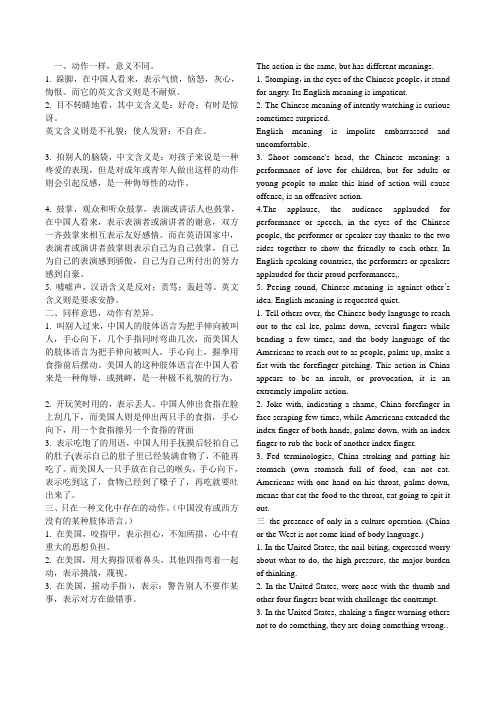
一、动作一样,意义不同。
1. 跺脚,在中国人看来,表示气愤,恼怒,灰心,悔恨。
而它的英文含义则是不耐烦。
2. 目不转睛地看,其中文含义是:好奇;有时是惊讶。
英文含义则是不礼貌;使人发窘;不自在。
3. 拍别人的脑袋,中文含义是:对孩子来说是一种疼爱的表现,但是对成年或青年人做出这样的动作则会引起反感,是一种侮辱性的动作。
4. 鼓掌,观众和听众鼓掌,表演或讲话人也鼓掌,在中国人看来,表示表演者或演讲者的谢意,双方一齐鼓掌来相互表示友好感情。
而在英语国家中,表演者或演讲者鼓掌则表示自己为自己鼓掌,自己为自己的表演感到骄傲,自己为自己所付出的努力感到自豪。
5. 嘘嘘声,汉语含义是反对;责骂;轰赶等。
英文含义则是要求安静。
二、同样意思,动作有差异。
1. 叫别人过来,中国人的肢体语言为把手伸向被叫人,手心向下,几个手指同时弯曲几次,而美国人的肢体语言为把手伸向被叫人,手心向上,握拳用食指前后摆动。
美国人的这种肢体语言在中国人看来是一种侮辱,或挑衅,是一种极不礼貌的行为。
2. 开玩笑时用的,表示丢人。
中国人伸出食指在脸上刮几下,而美国人则是伸出两只手的食指,手心向下,用一个食指擦另一个食指的背面3. 表示吃饱了的用语,中国人用手抚摸后轻拍自己的肚子(表示自己的肚子里已经装满食物了,不能再吃了。
而美国人一只手放在自己的喉头,手心向下,表示吃到这了,食物已经到了嗓子了,再吃就要吐出来了。
三、只在一种文化中存在的动作。
(中国没有或西方没有的某种肢体语言。
)1. 在美国,咬指甲,表示担心,不知所措,心中有重大的思想负担。
2. 在美国,用大拇指顶着鼻头,其他四指弯着一起动,表示挑战,蔑视。
3. 在美国,摇动手指),表示:警告别人不要作某事,表示对方在做错事。
The action is the same, but has different meanings. 1. Stomping,in the eyes of the Chinese people,it stand for angry. Its English meaning is impatient.2. The Chinese meaning of intently watching is curious sometimes surprised.English meaning is impolite embarrassed and uncomfortable.3. Shoot someone's head, the Chinese meaning: a performance of love for children, but for adults or young people to make this kind of action will cause offense, is an offensive action.4.The applause, the audience applauded for performance or speech, in the eyes of the Chinese people, the performer or speaker say thanks to the two sides together to show the friendly to each other. In English-speaking countries, the performers or speakers applauded for their proud performances,.5. Peeing sound, Chinese meaning is against other’s idea. English meaning is requested quiet.1. Tell others over, the Chinese body language to reach out to the cal lee, palms down, several fingers while bending a few times, and the body language of the Americans to reach out to as people, palms up, make a fist with the forefinger pitching. This action in China appears to be an insult, or provocation, it is an extremely impolite action.2. Joke with, indicating a shame, China forefinger in face scraping few times, while Americans extended the index finger of both hands, palms down, with an index finger to rub the back of another index finger.3. Fed terminologies, China stroking and patting his stomach (own stomach full of food, can not eat. Americans with one hand on his throat, palms down, means that eat the food to the throat, eat going to spit it out.三the presence of only in a culture operation. (China or the West is not some kind of body language.)1. In the United States, the nail-biting, expressed worry about what to do, the high pressure, the major burden of thinking.2. In the United States, wore nose with the thumb and other four fingers bent with challenge the contempt.3. In the United States, shaking a finger warning others not to do something, they are doing something wrong..4. 在美国,把胳膊放在胸前,握紧拳头,拇指向下,向下摆几次,表示反对某人;表示强烈反对。
中西方肢体语言的差异英语作文

中西方肢体语言的差异英语作文英文回答:Body language plays a crucial role in communication, conveying messages that words may not. However, cultural differences can lead to significant variations in the interpretation of body language, resulting in misunderstandings and even conflict. This essay will delve into the key differences between body language in Western and Eastern cultures.Eye Contact: In Western cultures, direct eye contact is generally considered a sign of sincerity, confidence, and trustworthiness. Maintaining eye contact while speaking indicates that you are engaged and attentive. However, in some Eastern cultures, prolonged eye contact can be perceived as aggressive or disrespectful. For example, in Japan, it is customary to avert one's gaze to show deference.Proximity: In Western cultures, there is a greater emphasis on personal space, and people tend to maintain a larger distance between themselves and others during conversations. Conversely, in many Eastern cultures, closer proximity is a sign of warmth and intimacy. For instance, in China, it is common to stand closer together and engage in more physical touch.Gestures: Gestures can convey a wide range of emotions and messages. However, the meaning of gestures can vary significantly across cultures. For example, the "thumbs up" gesture, which indicates approval in Western cultures, can be perceived as offensive in some Middle Eastern countries. Similarly, the "OK" sign, which represents agreement in the West, can be interpreted as an insult in Brazil.Body Posture: Body posture can communicate both physical and emotional states. In Western cultures, sitting or standing up straight is seen as a sign of confidence and alertness. However, in some Eastern cultures, a more relaxed posture may be considered more polite and respectful. For instance, in Thailand, it is considereddisrespectful to sit in a cross-legged position in front of an elder.Facial Expressions: Facial expressions are universal to some extent, but their interpretation can differ across cultures. For example, in Western cultures, smiling is generally associated with happiness and joy. However, in some Eastern cultures, smiling can also indicate discomfort or embarrassment. Similarly, the expression of anger may be more restrained in Eastern cultures, while it is more openly expressed in Western cultures.Cultural Context: It is important to note that body language should always be interpreted within its cultural context. What may be considered appropriate in one culture may be considered rude or disrespectful in another. For example, in Western cultures, it is common to shake hands as a greeting. However, in some Eastern cultures, it is more customary to bow or make a slight nod as a sign of respect.Understanding the cultural differences in body languagecan help avoid misinterpretations and facilitate effective communication. By being aware of these variations, individuals can adapt their nonverbal cues to the specific cultural context they are in, fostering betterintercultural connections and avoiding potential misunderstandings.中文回答:肢体语言在交流中起着至关重要的作用,它传达着言语无法表达的信息。
中西方肢体语言的差异英语作文

中西方肢体语言的差异英语作文英文回答:Body language is a form of non-verbal communicationthat involves the use of gestures, facial expressions, and body movements to convey messages. It is an essential part of human interaction, as it can help us to express our emotions, thoughts, and intentions.While body language is a universal form of communication, there are some significant differences between the way that it is used in different cultures. For example, in Western cultures, it is considered to be polite to make eye contact with someone when you are speaking to them. However, in some Asian cultures, it is considered to be disrespectful to do so.Another difference between Western and Eastern body language is the way that people use gestures. In Western cultures, gestures are often used to emphasize a point orto convey a specific message. However, in some Eastern cultures, gestures are used more sparingly and are often considered to be more subtle.Finally, there are also differences in the way that people use body language to express emotions. In Western cultures, it is common to express emotions openly and directly. However, in some Eastern cultures, it is considered to be more appropriate to express emotions indirectly or subtly.These are just a few of the many differences between Western and Eastern body language. It is important to be aware of these differences when interacting with people from other cultures, as it can help to avoid misunderstandings and miscommunications.中文回答:肢体语言是一种非语言交流形式,它涉及使用手势、面部表情和身体动作来传达信息。
中西肢体语言差异英语作文
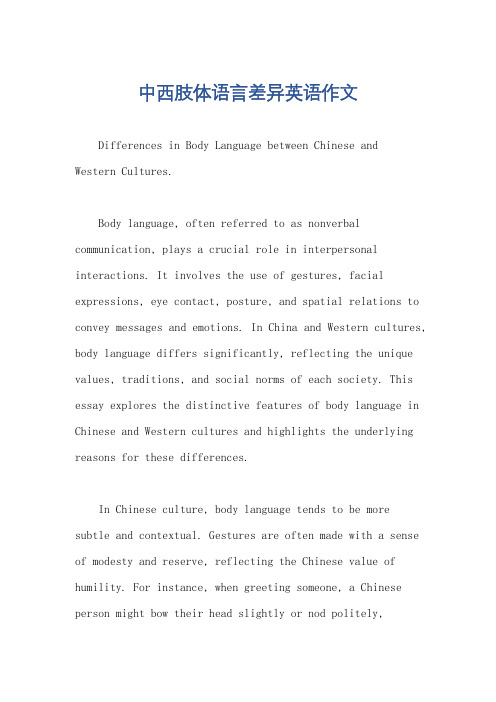
中西肢体语言差异英语作文Differences in Body Language between Chinese and Western Cultures.Body language, often referred to as nonverbal communication, plays a crucial role in interpersonal interactions. It involves the use of gestures, facial expressions, eye contact, posture, and spatial relations to convey messages and emotions. In China and Western cultures, body language differs significantly, reflecting the unique values, traditions, and social norms of each society. This essay explores the distinctive features of body language in Chinese and Western cultures and highlights the underlying reasons for these differences.In Chinese culture, body language tends to be moresubtle and contextual. Gestures are often made with a sense of modesty and reserve, reflecting the Chinese value of humility. For instance, when greeting someone, a Chinese person might bow their head slightly or nod politely,rather than embrace or shake hands as is common in Western cultures. This behavior is a testament to the Chinese emphasis on politeness and respect for authority.Facial expressions in Chinese culture are also rich in nuance. The eyes, in particular, are considered a window to the soul. Chinese people often communicate their thoughts and feelings through subtle changes in their eye gaze and facial expressions. A smile, for instance, can range from a polite greeting to a sincere expression of joy, depending on the context and the intensity of the expression.By contrast, Western body language tends to be more direct and expressive. Westerners often use more gestures and facial expressions to communicate their thoughts and emotions. Shaking hands is a common greeting practice in many Western countries, reflecting a culture of equality and friendliness. Westerners also tend to use more eye contact, which is often interpreted as a sign of sincerity and confidence.Posture and spatial relations also differ betweenChinese and Western cultures. In China, maintaining a low profile and avoiding conflict is highly valued. This is reflected in the posture of Chinese people, who often stand or sit with their backs straight but heads slightly bowed. In contrast, Westerners tend to adopt a more upright posture, reflecting their culture's emphasis onindividuality and assertiveness.Spatial relations are also differently interpreted in the two cultures. Chinese culture values harmony and close-knit communities, and therefore, personal space is often considered less important than in Western cultures. By contrast, Westerners tend to value privacy and personal space more highly, and they may find Chinese proximity and touching behaviors intrusive.The underlying reasons for these differences can be traced to the distinct historical, social, and cultural backgrounds of Chinese and Western cultures. Chinese culture, influenced by Confucianism and Taoism, emphasizes harmony, respect for authority, and modesty. These values shape the subtle and contextual nature of Chinese bodylanguage. By contrast, Western culture, influenced by Greco-Roman traditions and the Enlightenment, values individuality, freedom, and directness, which is reflected in the expressive and direct nature of Western body language.In conclusion, the differences in body language between Chinese and Western cultures reflect the unique values, traditions, and social norms of each society. Understanding these differences is crucial for effective cross-cultural communication and promoting mutual understanding and respect between people from different cultures. By embracing and adapting to these differences, we can build bridges of understanding and friendship across cultural divides.。
中西方肢体语言的差异英语作文
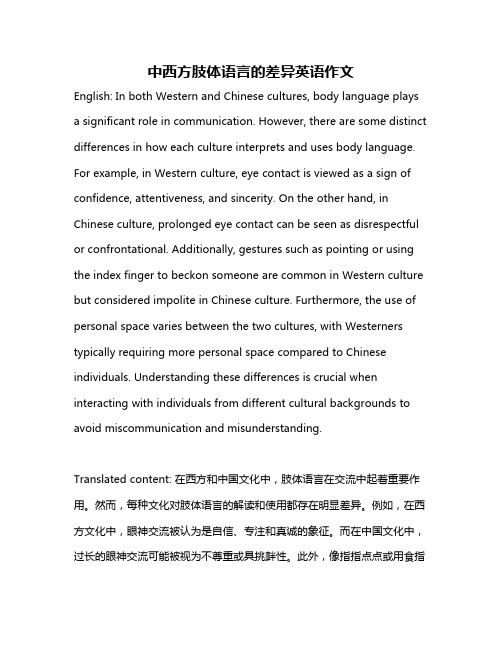
中西方肢体语言的差异英语作文English: In both Western and Chinese cultures, body language plays a significant role in communication. However, there are some distinct differences in how each culture interprets and uses body language. For example, in Western culture, eye contact is viewed as a sign of confidence, attentiveness, and sincerity. On the other hand, in Chinese culture, prolonged eye contact can be seen as disrespectful or confrontational. Additionally, gestures such as pointing or using the index finger to beckon someone are common in Western culture but considered impolite in Chinese culture. Furthermore, the use of personal space varies between the two cultures, with Westerners typically requiring more personal space compared to Chinese individuals. Understanding these differences is crucial when interacting with individuals from different cultural backgrounds to avoid miscommunication and misunderstanding.Translated content: 在西方和中国文化中,肢体语言在交流中起着重要作用。
中美肢体语言差异英语作文

中美肢体语言差异英语作文(中英文版)Title: Differences in Body Language between China and the United StatesBody language plays a significant role in communication, often conveying messages more effectively than words themselves.However, body language can vary greatly across different cultures.This essay aims to explore the differences in body language between China and the United States.In China, body language is often subtle and reserved.Handshakes are the most common form of greeting, especially in formal settings.When shaking hands, Chinese people tend to be more gentle and brief compared to their American counterparts.Bowing is also a common way to show respect, particularly when meeting someone of higher status.Direct eye contact can be seen as respectful and a sign of active listening, yet it is also important to avoid constant staring, which may be perceived as intrusive.In contrast, American body language is generally more expressive and open.Handshakes are common, but they tend to be firmer and more lingering.Americans often use hand gestures to emphasize their points during conversations.Eye contact is crucial, as it signifies honesty and engagement.In fact, avoiding eye contact in the United States maysuggest that a person is untruthful or disinterested.Personal space is another area where differences are evident.In China, people are accustomed to being in closer proximity to one another, and therefore, they may invade personal space without realizing it.Americans, on the other hand, value their personal space and may feel uncomfortable if someone stands too close.Body language during conversations also varies between the two cultures.In China, nodding and indirect head movements are common ways to show agreement or understanding.Silence is not necessarily seen as awkward and can be a sign of contemplation.In the United States, however, people tend to be more verbose and may view long periods of silence as a sign of discomfort or disinterest.In conclusion, the differences in body language between China and the United States reflect the cultural nuances of each society.Understanding these variations can help individuals communicate more effectively and avoid misunderstandings when interacting with people from different cultural backgrounds.标题:中美肢体语言差异肢体语言在交流中起着重要的作用,它往往比言语本身更能有效地传达信息。
中美肢体语言差异英语作文
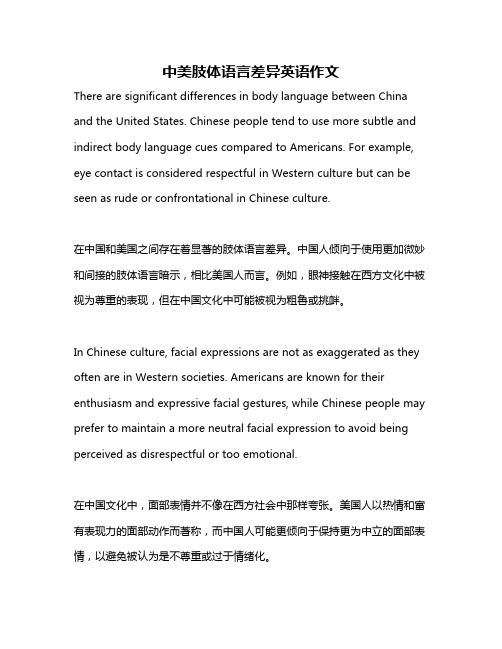
中美肢体语言差异英语作文There are significant differences in body language between China and the United States. Chinese people tend to use more subtle and indirect body language cues compared to Americans. For example, eye contact is considered respectful in Western culture but can be seen as rude or confrontational in Chinese culture.在中国和美国之间存在着显著的肢体语言差异。
中国人倾向于使用更加微妙和间接的肢体语言暗示,相比美国人而言。
例如,眼神接触在西方文化中被视为尊重的表现,但在中国文化中可能被视为粗鲁或挑衅。
In Chinese culture, facial expressions are not as exaggerated as they often are in Western societies. Americans are known for their enthusiasm and expressive facial gestures, while Chinese people may prefer to maintain a more neutral facial expression to avoid being perceived as disrespectful or too emotional.在中国文化中,面部表情并不像在西方社会中那样夸张。
美国人以热情和富有表现力的面部动作而著称,而中国人可能更倾向于保持更为中立的面部表情,以避免被认为是不尊重或过于情绪化。
肢体语言的中西方文化差异
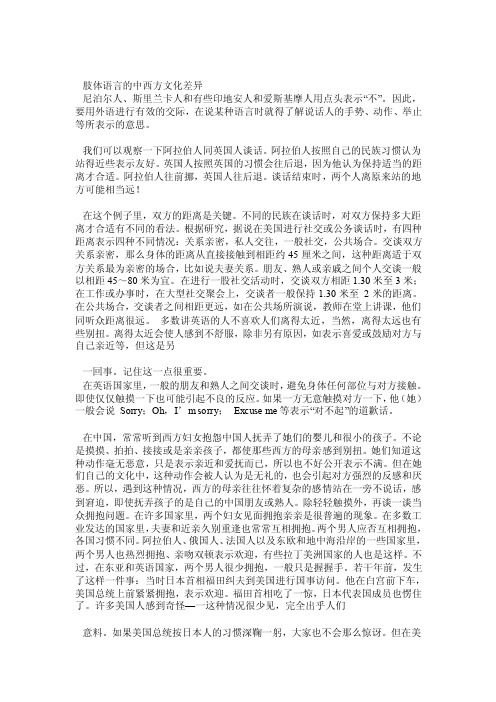
肢体语言的中西方文化差异尼泊尔人、斯里兰卡人和有些印地安人和爱斯基摩人用点头表示“不”。
因此,要用外语进行有效的交际,在说某种语言时就得了解说话人的手势、动作、举止等所表示的意思。
我们可以观察一下阿拉伯人同英国人谈话。
阿拉伯人按照自己的民族习惯认为站得近些表示友好。
英国人按照英国的习惯会往后退,因为他认为保持适当的距离才合适。
阿拉伯人往前挪,英国人往后退。
谈话结束时,两个人离原来站的地方可能相当远!在这个例子里,双方的距离是关键。
不同的民族在谈话时,对双方保持多大距离才合适有不同的看法。
根据研究,据说在美国进行社交或公务谈话时,有四种距离表示四种不同情况:关系亲密,私人交往,一般社交,公共场合。
交谈双方关系亲密,那么身体的距离从直接接触到相距约45厘米之间,这种距离适于双方关系最为亲密的场合,比如说夫妻关系。
朋友、熟人或亲戚之间个人交谈一般以相距45~80米为宜。
在进行一股社交活动时,交谈双方相距1.30米至3米;在工作或办事时,在大型社交聚会上,交谈者一般保持1.30米至2米的距离。
在公共场合,交谈者之间相距更远,如在公共场所演说,教师在堂上讲课,他们同听众距离很远。
多数讲英语的人不喜欢人们离得太近,当然,离得太远也有些别扭。
离得太近会使人感到不舒服,除非另有原因,如表示喜爱或鼓励对方与自己亲近等,但这是另一回事。
记住这一点很重要。
在英语国家里,一般的朋友和熟人之间交谈时,避免身体任何部位与对方接触。
即使仅仅触摸一下也可能引起不良的反应。
如果一方无意触摸对方一下,他(她)一般会说Sorry;Oh,I’m sorry;Excuse me等表示“对不起”的道歉话。
在中国,常常听到西方妇女抱怨中国人抚弄了她们的婴儿和很小的孩子。
不论是摸摸、拍拍、接接或是亲亲孩子,都使那些西方的母亲感到别扭。
她们知道这种动作毫无恶意,只是表示亲近和爱抚而已,所以也不好公开表示不满。
但在她们自己的文化中,这种动作会被人认为是无礼的,也会引起对方强烈的反感和厌恶。
中美身体语言差异英语作文
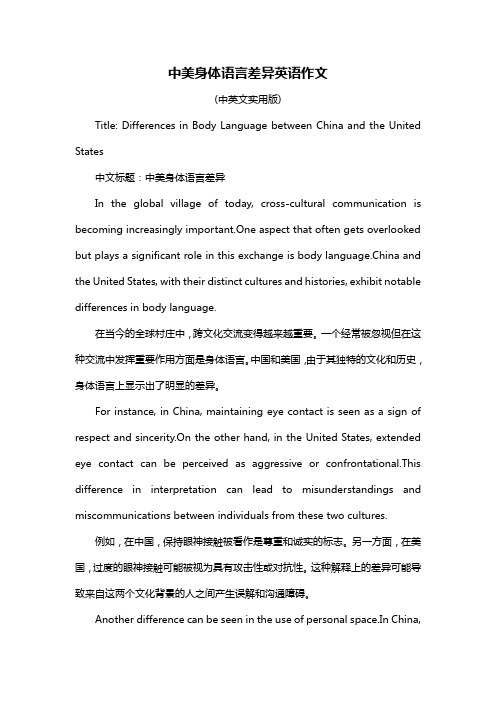
中美身体语言差异英语作文(中英文实用版)Title: Differences in Body Language between China and the United States中文标题:中美身体语言差异In the global village of today, cross-cultural communication is becoming increasingly important.One aspect that often gets overlooked but plays a significant role in this exchange is body language.China and the United States, with their distinct cultures and histories, exhibit notable differences in body language.在当今的全球村庄中,跨文化交流变得越来越重要。
一个经常被忽视但在这种交流中发挥重要作用方面是身体语言。
中国和美国,由于其独特的文化和历史,身体语言上显示出了明显的差异。
For instance, in China, maintaining eye contact is seen as a sign of respect and sincerity.On the other hand, in the United States, extended eye contact can be perceived as aggressive or confrontational.This difference in interpretation can lead to misunderstandings and miscommunications between individuals from these two cultures.例如,在中国,保持眼神接触被看作是尊重和诚实的标志。
中外动作差异
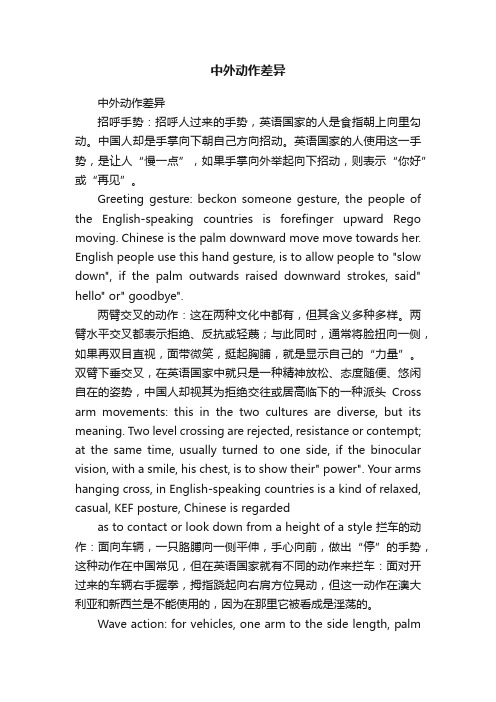
中外动作差异中外动作差异招呼手势:招呼人过来的手势,英语国家的人是食指朝上向里勾动。
中国人却是手掌向下朝自己方向招动。
英语国家的人使用这一手势,是让人“慢一点”,如果手掌向外举起向下招动,则表示“你好”或“再见”。
Greeting gesture: beckon someone gesture, the people of the English-speaking countries is forefinger upward Rego moving. Chinese is the palm downward move move towards her. English people use this hand gesture, is to allow people to "slow down", if the palm outwards raised downward strokes, said" hello" or" goodbye".两臂交叉的动作:这在两种文化中都有,但其含义多种多样。
两臂水平交叉都表示拒绝、反抗或轻蔑;与此同时,通常将脸扭向一侧,如果再双目直视,面带微笑,挺起胸脯,就是显示自己的“力量”。
双臂下垂交叉,在英语国家中就只是一种精神放松、态度随便、悠闲自在的姿势,中国人却视其为拒绝交往或居高临下的一种派头Cross arm movements: this in the two cultures are diverse, but its meaning. Two level crossing are rejected, resistance or contempt; at the same time, usually turned to one side, if the binocular vision, with a smile, his chest, is to show their" power". Your arms hanging cross, in English-speaking countries is a kind of relaxed, casual, KEF posture, Chinese is regardedas to contact or look down from a height of a style 拦车的动作:面向车辆,一只胳膊向一侧平伸,手心向前,做出“停”的手势,这种动作在中国常见,但在英语国家就有不同的动作来拦车:面对开过来的车辆右手握拳,拇指跷起向右肩方位晃动,但这一动作在澳大利亚和新西兰是不能使用的,因为在那里它被看成是淫荡的。
- 1、下载文档前请自行甄别文档内容的完整性,平台不提供额外的编辑、内容补充、找答案等附加服务。
- 2、"仅部分预览"的文档,不可在线预览部分如存在完整性等问题,可反馈申请退款(可完整预览的文档不适用该条件!)。
- 3、如文档侵犯您的权益,请联系客服反馈,我们会尽快为您处理(人工客服工作时间:9:00-18:30)。
一、动作一样,意义不同。
1. 跺脚,在中国人看来,表示气愤,恼怒,灰心,悔恨。
而它的英文含义则是不耐烦。
2. 目不转睛地看,其中文含义是:好奇;有时是惊讶。
英文含义则是不礼貌;使人发窘;不自在。
3. 拍别人的脑袋,中文含义是:对孩子来说是一种疼爱的表现,但是对成年或青年人做出这样的动作则会引起反感,是一种侮辱性的动作。
4. 鼓掌,观众和听众鼓掌,表演或讲话人也鼓掌,在中国人看来,表示表演者或演讲者的谢意,双方一齐鼓掌来相互表示友好感情。
而在英语国家中,表演者或演讲者鼓掌则表示自己为自己鼓掌,自己为自己的表演感到骄傲,自己为自己所付出的努力感到自豪。
5. 嘘嘘声,汉语含义是反对;责骂;轰赶等。
英文含义则是要求安静。
二、同样意思,动作有差异。
1. 叫别人过来,中国人的肢体语言为把手伸向被叫人,手心向下,几个手指同时弯曲几次,而美国人的肢体语言为把手伸向被叫人,手心向上,握拳用食指前后摆动。
美国人的这种肢体语言在中国人看来是一种侮辱,或挑衅,是一种极不礼貌的行为。
2. 开玩笑时用的,表示丢人。
中国人伸出食指在脸上刮几下,而美国人则是伸出两只手的食指,手心向下,用一个食指擦另一个食指的背面3. 表示吃饱了的用语,中国人用手抚摸后轻拍自己的肚子(表示自己的肚子里已经装满食物了,不能再吃了。
而美国人一只手放在自己的喉头,手心向下,表示吃到这了,食物已经到了嗓子了,再吃就要吐出来了。
三、只在一种文化中存在的动作。
(中国没有或西方没有的某种肢体语言。
)1. 在美国,咬指甲,表示担心,不知所措,心中有重大的思想负担。
2. 在美国,用大拇指顶着鼻头,其他四指弯着一起动,表示挑战,蔑视。
3. 在美国,摇动手指),表示:警告别人不要作某事,表示对方在做错事。
The action is the same, but has different meanings. 1. Stomping,in the eyes of the Chinese people,it stand for angry. Its English meaning is impatient.2. The Chinese meaning of intently watching is curious sometimes surprised.English meaning is impolite embarrassed and uncomfortable.3. Shoot someone's head, the Chinese meaning: a performance of love for children, but for adults or young people to make this kind of action will cause offense, is an offensive action.4.The applause, the audience applauded for performance or speech, in the eyes of the Chinese people, the performer or speaker say thanks to the two sides together to show the friendly to each other. In English-speaking countries, the performers or speakers applauded for their proud performances,.5. Peeing sound, Chinese meaning is against other’s idea. English meaning is requested quiet.1. Tell others over, the Chinese body language to reach out to the cal lee, palms down, several fingers while bending a few times, and the body language of the Americans to reach out to as people, palms up, make a fist with the forefinger pitching. This action in China appears to be an insult, or provocation, it is an extremely impolite action.2. Joke with, indicating a shame, China forefinger in face scraping few times, while Americans extended the index finger of both hands, palms down, with an index finger to rub the back of another index finger.3. Fed terminologies, China stroking and patting his stomach (own stomach full of food, can not eat. Americans with one hand on his throat, palms down, means that eat the food to the throat, eat going to spit it out.三the presence of only in a culture operation. (China or the West is not some kind of body language.)1. In the United States, the nail-biting, expressed worry about what to do, the high pressure, the major burden of thinking.2. In the United States, wore nose with the thumb and other four fingers bent with challenge the contempt.3. In the United States, shaking a finger warning others not to do something, they are doing something wrong..4. 在美国,把胳膊放在胸前,握紧拳头,拇指向下,向下摆几次,表示反对某人;表示强烈反对。
5. 眨眼(很快地合上一只眼,微微一笑点点头)表示下列几种感情:会意,赞许,鼓励,传递信息,表示团结等6. 在中国,用食指点点或指指自己的鼻子,表示“是我”,“是我干的”,但是,在美国人看来,这是比较滑稽可笑的。
7. 在中国,说话时用一只张开的手捂着嘴。
表示,正在谈论秘密的事情。
8. 在中国,两只手递东西给客人或别人,表示尊敬。
9. 别人为自己倒茶或斟酒时,张开一只手或两只手,放在杯子旁边表示感谢。
尼泊尔人、斯里兰卡人和有些印地安人和爱斯基摩人用点头表示“不”。
阿拉伯人按照自己的民族习惯认为站得近些表示友好。
英国人按照英国的习惯会往后退,因为他认为保持适当的距离才合适4. In the United States, put arms on one’s chest, clenched fists, thumbs down to the hem several times, expressed opposed to someone; expressed strong opposition.5. Blink of an eye (to quickly closed one eye, smiled and nodded) Feelings of the following: knowing, praise, encourage, transmission of information, expressed solidarity6. In China, with the index finger little or pointed to one’s nose, means, it’s me, however, in Americans’ eyes, this is funny.7. In China, speak with an open hand muzzled. Means who is talking about secret things.In China, handed something with two hands for the guests or others, show respect.9 others pouring or pour wine for themselves, open with one hand or two hands, on cup beside thanked.Nepalese, Sri Lankan ,some Indians and Eskimos nodded and said "no."Arabs in accordance with their own national habits that stand recently said friendly. Following the British tradition, the British would go back only because he believes that maintaining the proper distance。
